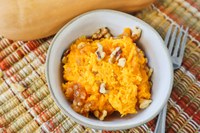Prairie Fare: Harvest the health benefits of colorful fruits and vegetables
(Click an image below to view a high-resolution image that can be downloaded)
Recently I was at a conference in another state for a week. The leaves at home were green when I left, and they were green in the state I visited. As I arrived home, I noticed the leaves were turning yellow, orange and red.
I enjoy the colors of fall. However, I get a little nostalgic when the leaves begin to turn color. I think of my now-grown children when they used their child-size rakes helping us clean up the yard and fill orange pumpkin bags.
Sometimes my kids would jump on the bags after they were full. Some of the bags would break.
We would fix the bags with duct tape and start over with filling them.
We can enjoy nature’s colors on our plate. Color can be a cue to good nutrition. Fruits and vegetables can be red, orange, yellow, green, blue/purple or white.
Let’s try a little activity. Think about what you ate yesterday.
If you ate the skin (such as on a red apple), you would count the fruit or vegetable as “red.” A banana would count as a white fruit, because we typically do not eat the skin. Any form of fruits and vegetables counts, including fresh, canned, frozen and dried.
- What fruits or vegetables did you have for breakfast? What colors were they? How much did you consume (in cups)?
- What fruits or vegetables did you have for lunch? What colors were they? How much did you consume (in cups)?
- What fruits or vegetables did you have for dinner? What colors? How much did you consume (in cups)?
- What fruits or vegetables did you have for snacks? What colors? How much did you consume (in cups)?
How did you do? The current recommendation for adults is to consume at least 4.5 cups of fruits and vegetables per day, mainly whole fruits. Juice counts toward the total but nutrition experts recommend consuming your fruits and vegetables in “whole form” because fiber often is lost in the juicing process. Fill half your plate with fruits and vegetables and include a rainbow of colors.
Why all the emphasis on fruits and vegetables in the world of nutrition? Most people shortchange themselves on fruits and vegetables.
Fruits and vegetables provide our bodies with vitamins, minerals and “phytochemicals” (natural plant chemicals). These are a few examples of natural pigments.
Lycopene is found in red fruits and vegetables such as tomatoes, pink grapefruit and watermelon. This natural plant chemical may help prevent certain types of cancer and heart disease.
Beta-carotene is found in orange, gold and some green fruits and vegetables such as apricots, mangoes, cantaloupe, pumpkin, sweet potato, carrots, squash, spinach, kale and broccoli. This helps keep our skin, bones, vision and immune system healthy.
Anthocyanins are found in blueberries, blackberries, plums, cranberries, raspberries, red cabbage, red and black grapes, red onions, red potatoes, strawberries and other foods. They act as “antioxidants” and protect our cells from damage and diseases, including cancer.
Let nature inspire your plate this fall. Enjoy the seasonal apples, squash, pumpkins, potatoes and more. Visit our “Field to Fork” website at www.ag.ndsu.edu/fieldtofork for more information.
Here’s a favorite recipe from the 800 Café, a student-run restaurant on campus at NDSU. I always look forward to this nutritious side dish that goes well with a variety of proteins, including beef, pork and chicken. Actually, I could eat this side dish for dessert.
Butternut Squash Bake
2 large eggs
6 ounces canned evaporated non-fat milk
2 teaspoons vanilla extra
1/4 cup granulated sugar
4 cups cooked butternut squash (about 2.5 pounds before preparation)
2/3 cup crisp rice cereal
1/4 cup plus 2 tablespoons brown sugar
1/4 cup melted butter
Chopped walnuts or pecans (optional)
Prepare squash by rinsing with cool water and scrubbing skin if needed. Next, cut squash in half and lay flesh side down on greased baking sheet. Poke holes in skin and allow to cook for 45 minutes to one hour at 350 F. Mix eggs, milk, vanilla and sugar together by hand or use a hand mixer. After squash is cooked, scoop out four cups using a spoon and measuring cup. Add squash to milk and eggs mixture. Mix until combined. Pour mixture into a greased 9-by-13-inch baking dish. Melt butter in microwave and combine cereal, brown sugar and butter in a bowl. Sprinkle brown sugar topping over squash mixture. Add nuts if desired. Bake at 350 F for 30 minutes.
Makes 10 (1/2 c.) servings. Each serving has 180 calories, 7 grams (g) fat, 4 g protein, 26 g carbohydrate, 3 g fiber and 50 milligrams sodium.
(Julie Garden-Robinson, Ph.D., R.D., L.R.D., is a North Dakota State University Extension food and nutrition specialist and professor in the Department of Health, Nutrition and Exercise Sciences. Follow her on Twitter @jgardenrobinson)
NDSU Agriculture Communication – Sept. 22, 2022
Source: Julie Garden-Robinson, 701-231-7187, julie.garden-robinson@ndsu.edu
Editor: Elizabeth Cronin, 701-231-5391, elizabeth.cronin@ndsu.edu




